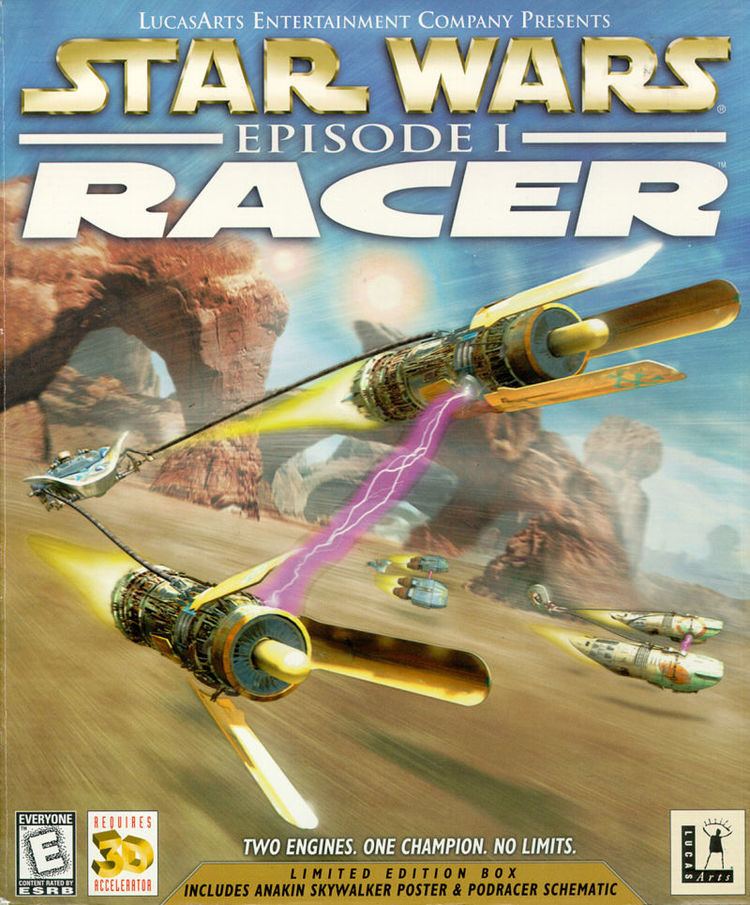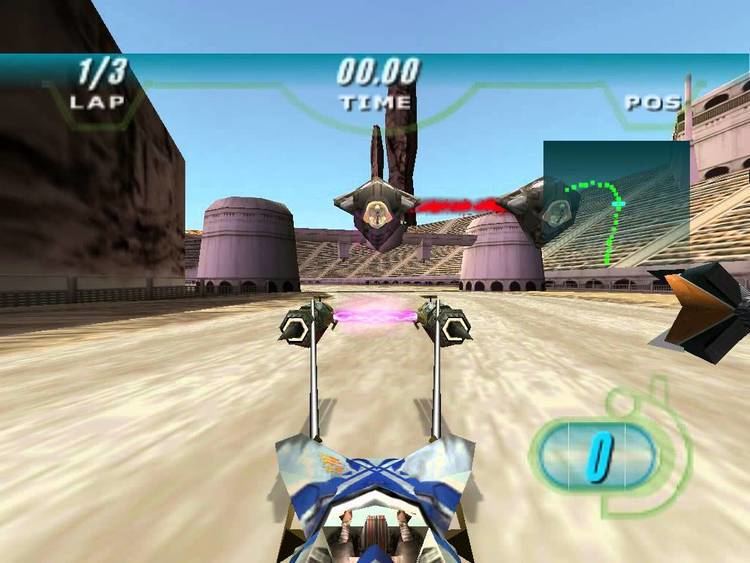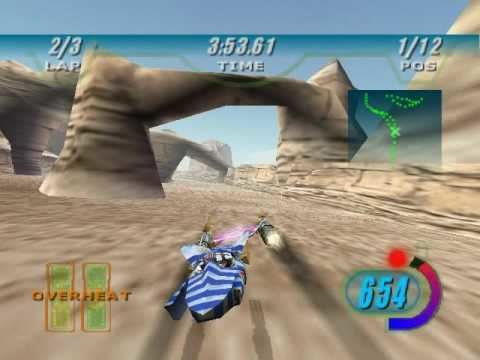9 /10 1 Votes9
Distributor(s) Nintendo (N64) Genre Racing video game Publishers Nintendo, LucasArts, Sega | 4.5/5 Emuparadise Initial release date 1999 Developers LucasArts, Pax Softnica | |||||||||||||||||||||||||||||||||
 | ||||||||||||||||||||||||||||||||||
Modes Single-player video game, Multiplayer video game Similar LucasArts games, Racing video games | ||||||||||||||||||||||||||||||||||
Nintendo 64 longplay 048 star wars episode i racer
Star Wars Episode I: Racer is a racing video game based on the podracing sequence featured in Star Wars: Episode I – The Phantom Menace. Unlike the film, Episode I: Racer allows players to follow any racer they choose. The game features all of the racers and race course on Tatooine featured in The Phantom Menace. It also adds several new courses, some on Tatooine, others on various planets. Several single player modes, including a tournament mode, are available for play. It also features multiplayer, the format of which varies by platform. Jake Lloyd, who portrayed Anakin Skywalker in The Phantom Menace, reprises his role in the game.
Contents
- Nintendo 64 longplay 048 star wars episode i racer
- Star wars episode i racer austin eruption
- Gameplay
- Development and release
- Reception and legacy
- References

Episode I: Racer was received generally positive reviews from critics. Several major media outlets listed it as one of the top Star Wars video games. As of 2011, the game holds the Guinness record as the best-selling sci-fi racing game, having worldwide sales of 3.12 million and beating other series like Wipeout and F-Zero. Two titles featuring podracing were released after Episode I: Racer's release. Star Wars: Racer Arcade, an arcade version of the game featuring many similar tracks and characters, was released in 2000. Kinect Star Wars, which utilizes the Xbox 360 Kinect, also featured podracing as one of its game modes.

Star wars episode i racer austin eruption
Gameplay

Star Wars Episode I: Racer features a variety of tracks spanning several different planets. It also includes all of the racers featured in the movie as well as additional competitors exclusive to the game. The player character's podracer is equipped with a boost function that the player can activate. While activated the podracer's temperature will rise, and if the player boosts for too long of an interval a penalty will be incurred. The player can also actively repair the podracer while competing, however doing so results in a slower overall speed until repairs are either complete or stopped.

Three single player game modes are available in the game. In Tournament mode, the player character completes in a championship. Completing races awards money, with higher ranked finishes resulting in higher payouts. This can be used to buy parts or repair droids, unlock new tracks, and unlock new racers. Free Race mode allows the player to practice any previously unlocked courses using any unlocked racer. The player character cannot earn money or unlock tracks and racers, but can set the difficulty of the opponents. Time Attack pits the player character against the clock, racing along to try to complete the fastest time on the given course. This mode is absent from the PC version. Instead the Free Play mode allows the player to set the number of computer opponents to 0.
Multiplayer is also offered on all platforms, though it differs differs between the PC and console versions. The Nintendo 64 and Sega Dreamcast versions feature a two player splitscreen mode, while the Windows and Macintosh versions allow for play over a Local Area Network (LAN). This Windows version uses the deprecated IPX protocol to accomplish this, while the Macintosh version uses the TCP/IP stack. The multiplayer mode can support up to 8 players.
Development and release
Star Wars Episode I: Racer was developed and published by LucasArts for Windows PCs in April 1999. Development took approximately two years. Two project leads responsible for Star Wars: Shadows of the Empire began initial development once Shadows was completed. The game was developed in-house at LucasArts. Tools used during development included 3D Studio Max, Alias Wavefront and Autodesk Softimage. During development, multiple graphical Application programming interfaces (APIs) were tested, including 3dfx Glide, OpenGL, and Direct3D. Ultimately the game shipped with only Direct3D support because according to Project Lead Brett Tosti when testing Glide and OpenGL the developers "didn’t see any performance increases so didn’t add support." The team had to develop their physics simulation in the game from only a few short clips of the film given to them. According to Tosti, their approximations ended up very close to the film. "We really didn’t get to see how good our estimates were until the very end." Project lead John Knoles emphasized that the team's goal was for a strong sense of speed. He stated they wanted to make it "feel like an eyeball-peeling racing game, where you're going so fast, you're just nervous."
The game was originally titled Star Wars: Podracer, however the subtitle was changed to Episode I Racer when LucasArts learned that another company owned the trademark for games with the name "Pod" in the title. Actor Jake Lloyd, who portrayed Anakin Skywalker in Star Wars Episode I: The Phantom Menace, promoted the game at E3 1999. Lloyd also provided voice over for his character in the game. The theatrical score from Star Wars: Episode I – The Phantom Menace was reused for the game, and various sound effects from the film were also reused. The podracers were recreated using specifications from the film, and the Tatooine environment was also sourced from the film. Several of the game's other locales had never appeared in a Star Wars game prior. The varied environments, Tosti said, were to "to add more depth to the gameplay." During an IGN interview with LucasArts' Tom Byron at E3 1999 the question of online play was brought up. Byron was unsure, citing problems "mostly because of latency issues." Some multiplayer code from Star Wars Jedi Knight: Dark Forces II was utilized for Episode I: Racer. Ultimately internet play was not included. The Windows version uses the deprecated IPX protocol to accomplish this, while the Macintosh version uses the TCP/IP stack. The multiplayer mode can support up to 8 players.
Episode I: Racer was later ported and released for several other platforms: Nintendo 64, Dreamcast, and Game Boy Color. The announced PlayStation version of the game was never released. The Nintendo 64 version received a special edition Star Wars Episode I: Racer hardware bundle, including the standard gray and black console and a copy of the game. Though the Nintendo 64 cartridge takes advantage of Nintendo's Expansion Pak memory unit to display additional textures, the limited capacity of the cartridge resulted in the removal of all pre-rendered cutscenes seen on the Windows and Macintosh versions. It was the first LucasArts game to be released on the Dreamcast. The game's Windows release has issues running on 64-bit installations of Windows. The Game Boy Color release features entirely different game play from its console and PC counterparts. The Game Boy Color hardware is technically incapable of rendering the 3D graphics used in the other versions, so the game was instead based on abbreviated tracks using an overhead 2D view. The Game Boy Color version of the game has an additional "Rumble" feature, in which a AAA battery may be inserted into the game card to activate vibration.
Reception and legacy
The game was met with positive to average reception. GameRankings gave it a score of 75.78% for the Nintendo 64 version; 75.42% for the Dreamcast version; 73.79% for the PC version; and 69.44% for the Game Boy Color version. It has been featured on several lists of the best Star Wars video games. In March 2004, GMR rated Episode I: Racer the fifth best Star Wars game of all time. In 2015 PC Gamer listed it 3rd in their list of top Star Wars games. That same year it placed 10th in Rock, Paper, Shotgun's top games list. In Game Informer's 2016 list of the 30 best Star Wars video games Racer ranked 11th. As of 2011, the game holds the Guinness record for the best-selling sci-fi racing game having worldwide sales of 3.12 million beating other series like Wipeout and F-Zero.
Two additional Star Wars video games feature podracing. An arcade game titled Star Wars: Racer Arcade was released in 2000 It features similar tracks and racers. The game is played using two throttle controls similar to those found in the film's podracers. Additionally the Xbox 360 Kinect game Kinect Star Wars features podracing. In this game players user their arms to mimic holding the controls of a podracer.
